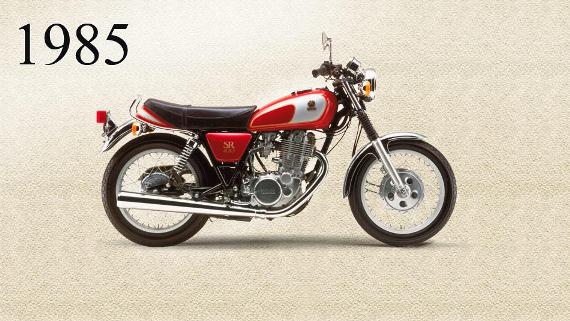The Yamaha SR400 has been attracting massive interest
1. The origin
The single cylinder SR400 and SR500 were announced in 1978 by Yamaha Motor Company as a street version of the Yamaha XT500 with a standard riding posture and styling resembling the Universal Japanese Motorcycle (UJM) of the 1960s and 1970s, and went on to become some of Yamaha’s most popular and enduring models.

Yamaha XT500
Meanwhile, in Japan, legislation relating to the motorcycle licensing system in the mid 1970s had created demand for 400cc models, and so the SR400 has been marketed in the Japanese Domestic Market (JDM) since 1978 . The SR400 became a top seller in its home market, virtually identical to the SR500 but SR400 engine has a lower displacement, achieved with a different crankshaft and shorter piston stroke and both models with only kickstarting, no electric starter. The SR400 has continued to attract massive interest in Japan over the last 35 years and was introduced to Europe, the Americas and Oceania in 2014.
The SR500 was marketed in Asia and Oceania (1978-1999), North America (1978-1981); and Europe (1978-1983). In many European countries including Germany, Austria and Belgium, groups of SR500 owners formed enthusiasts’ clubs, many of which still run to this day. To underline its appeal, the SR500 went on to win consecutive ‘Moto of the Year’ awards from Germany’s Motorrad magazine – one of the highest circulation motorcycle titles in Europe.
2. The Yamaha SR400 model change history
1978 – First Generation

19″ front wheel with disk brake
18″ rear wheel with drum brake
SR400 – VM32 carburetor
SR500 – VM34SS carburetor
1985 – Second generation

– 18″ front and rear wheels with drum brakes front and rear
– Rearsets revised
– Gas tank upgraded from 12 litres to 14 litres
1988
– Carburettor changed to Vacuum Mikuni BST34/1
– Cam shaft changes to enhance low and mid range
1993
– AC Magneto redesigned/improved to increase output for constant headlight usage during day and night.Flywheel cover changed to suit.
– Battery changed from acid to gel
– Revised fuel cap design like a shell
– Side-stand sensor added
1996
– Rear-set reverted to first generation design
– Revised handlebar design
– Tank reverted back to 12 original 12 litre capacity
1999 – Final production year for SR500

2001 – Third Generation

18″ front wheel with disk brake
18″ rear wheel with drum brake
Change to BSR33 carburetor
Revised air-intake system to burn leftover fuel
Changed from an AC-CDI to a DC-CDI. This improved ignition accuracy and cold-start reliability
2003
– Immobiliser added
– Throttle position sensor added
2009 – Yamaha suspended production of the SR400 during this year
2010 – Fourth Generation

– Fuel system changed to Injection, which boasts much better performance, reliability, and emissions control.
– O2 Sensor added to exhaust header and temp sensor added to cylinder head.
– Revised fuel tank, added fuel pump behind the side-cover, revised flywheel & seat
– Battery moved to under seat
– Meter design and side-cover design changed
For 2013 Yamaha SR400 35th Anniversary Edition

The Yamaha SR400 keeps fuel-injection, which was added in 2010 to help meet emissions requirements, but it remains a kick-start motorcycle.
The 399cc thumper makes 30 horsepower at 7,500 rpm, and 23 ft.-lb. of torque at 6,200 rpm. Transmission is five speed and the anniversary edition’s paint is a green metallic finish. Dry weight is 383 lbs. Fuel mileage is 96.4 mpg. That means you should be able to ride for 288 miles (or 463 kilometers) before running on fumes. Not bad for a 12 litre tank.
Source: yamaha-motor.eu, bikermetric.com.
To identify yamaha SR 400 models
To identify yamaha SR 400 models P.2




